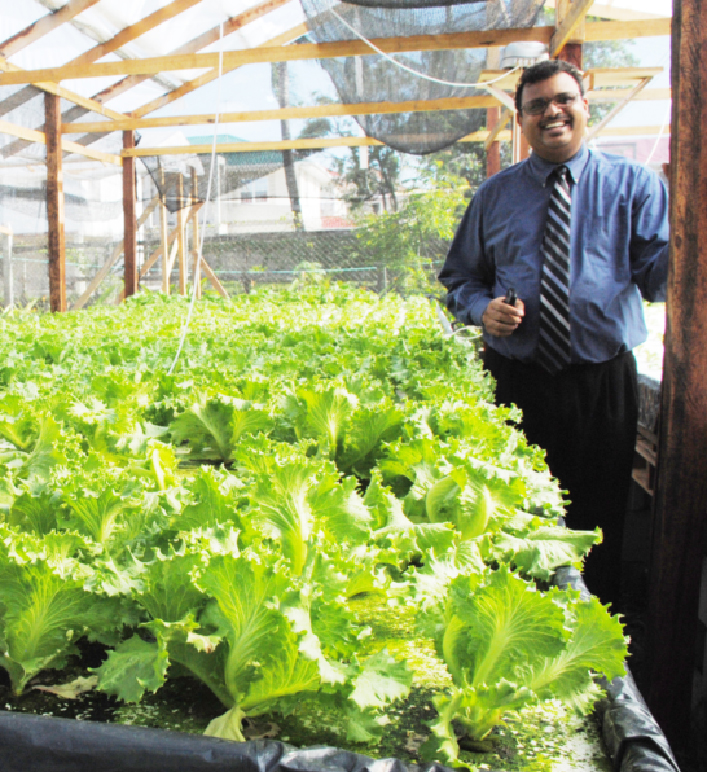Dr Suresh Persaud insists that he is not a farmer. The legitimacy of such claims as he can make to the land are limited to his grandfather’s pursuit of rice farming, in which he took no interest.
Dr Persaud is, however, one of a growing number of non-farming Guyanese who have developed a passion for hydroponics, an age-old subset of horticulture that employs a method of cultivation that uses mineral nutrient solutions to cultivate a limited range of fruits and vegetables in various substrates, even water. Not that the pursuit is new to Guyana either, though the current Farmer to Farmer Project being executed by the Partners of the Americas project appears to have rekindled interest in the discipline.

The uniqueness of hydroponics reposes in the fact that crops are not planted in the ground. More than that, the pursuit of hydroponics, even on a commercial scale, requires much less space than traditional agriculture. That apart, it is far less labour-intensive; a consideration which, perhaps, makes it more appealing to urban dwellers.
Dr Persaud does not rule out those considerations though his own stated reason for being involved in the pursuit is that he is “attracted to the science of it.”
Hydroponics first caught his attention during a visit to Disney World which was hosting a state-of-the-art hydroponic facility at Epcot in Orlando. His interest in hydroponics was immediate. More than that, it was supplemented by subsequent reading on the subject.
Like many other local adherents of the discipline his interest in hydroponics has been fuelled by considerations that have to do with “eating healthy”. He recalls that the 2005 floods had created concerns associated with “eating from the land.” At the same time he was far from enthusiastic about purchasing foods from the markets that were literally being stored on the ground.
He credits Sigmund McKenzie, who currently serves as a Technical Assistant with the Partners of the Americas Farmer to Farmer Project with enhancing both his knowledge and his interest in the discipline and his unfolding discovery that the pursuit of hydroponics provided the opportunity he described as “a controlled environment” and pushed him in that direction.
At his Lamaha Gardens home Dr Persaud has created a huge laboratory out of what appears to be most of the available space outside of the living quarters occupied by himself, his wife and his two young children. Impressive Shadehouses border his property on all sides save an except the entrance to his premises.
Inside the Shadehouses crisp-looking heads of lettuce pop up from holes punched in sheets of polystyrene that provide stability for the roots while concealing the network of pipes and tubes that provide the water and nutrients that nourish the lettuce.
The rest of the premises is crowded with neat rows of pots boasting what appears to be various experimental pursuits in hydroponics including bell peppers planted in paddy shell and sand. Dr Persaud says that lettuce apart, his interests include tomatoes, bell peppers and red onions; crops which he intends to subject to experiments that have to do with the best method of growing them.
Having conceded that he is attracted to “the science” of hydroponics Dr Persaud is quick to add that he is not unaware of the commercial potential of his pursuits. The venture is already a registered business under the name Shade Tree Investments which is managed by wife Sabrina. The company has secured a limited market that includes a popular supermarket and Dr Persaud is currently engaged in seeking to acquire space beyond the confines of his now crowded premises to expand the venture.
It is, he says, much too soon to be drawn on the specifics of profitability. There are more markets to be secured and there is also the need to expand production to meet market demand. That apart, Dr Persaud believes that the science of hydroponics continues to evolve and that there is still much research to be done to increase the pursuit’s viability. He is, for example, experimenting with various possible substrates in which different crops might grow.
His assessment of the future of hydroponic cultivation is positive without being wildly optimistic. He is under no illusions about the mountains of tradition surrounding traditional farming in Guyana and concedes that “it would be difficult to persuade the vast majority of traditional farmers” to switch to hydroponics. He believes, however, that food consumption patterns are headed in the direction of healthier eating and that the niche market that is continually opening up to hydroponic foods is continuing to grow. Much of the potential market, he says, reposes in the growing number of supermarkets, hotels and guest houses springing up in Guyana and which seek to measure up to the higher standards of an increasingly more demanding clientele.




